Wingspan’s Oceania Expansion introduced end-of-game yellow powers. In total, there are currently 19 yellow-powered birds.
It’s important to remember that Wingspan yellow powers trigger at the end of round four, after all other activities have been completed:
- Use “round end” bird powers if playing with the European Expansion.
- Discard any unused nectar.
- Score end-of-round goal.
- Remove all action cubes.
- Discard and replace all cards in the bird tray.
- If round 4 is over, use game-end powers. Otherwise, pass the first player token clockwise.
See page two of the Oceania Expansion Rulebook for the order in which to resolve end-of-game actions.
Wingspan Yellow-Powered Card Rankings – A Wingsplain Exclusive
Nine of these birds lay eggs in some fashion. That’s 47% of all yellow powers. That’s an interesting stat considering the Oceania Expansion implements new boards with redesigned habitats in which the Grasslands generate fewer eggs in general over the course of a game.
These end-of-game egg-laying powers try to make up for this by “bursting” eggs onto the board much in the same way that birds like Bobolink, Inca Dove, and Ash-Throated Flycatcher do (core set birds). However, they do it after the point where those eggs can be used as resources to play more birds or fuel other powers or bonus conversions.
The implementation of these effects fits the mechanical theme of the Oceania Expansion. Measures were generally taken to reduce in-game egg production and address the negative opinions regarding “egg spam,” that is, the criticism that the game devolved into “just laying eggs” in the closing turns. This still happens sometimes; it just takes more resources to get there.
Much like pink and teal powers, if a Wingspan yellow power is situational/limited/restricted, the bird it’s attached to needs to have good general qualities to make it valuable when it’s just sitting there and waiting to use its power. This is even more important for yellow-powered birds since they will only trigger once, regardless of what any player does.
The nature of these birds lend them to being late game point bombs. Unless their general qualities are beneficial during the game, you need to play cards around them, or you need them to reach deeper columns in your habitat; save them until later if you can.
16. Pacific Black Duck
Trying to maximize this power puts you at the mercy of the deck as you hope to draw into Wetlands birds with larger nest sizes. You need twelve eggs on Wetlands birds to get six eggs out of the PBD. You’re also going to need some birds in your Grasslands to help you get those twelve eggs with some efficiency.
The silver lining is that you will be drawing a larger volume of cards from a more fleshed-out Wetlands engine. If you managed to pull this off, it would result in eight points for two food spent. There are easier ways to score eight points than this. This bird isn’t saved by its bonus card interactions.
15. Australian Magpie
Playing this bird early and playing your whole game around it, allowing it to influence your decisions, seems like a trap to me since it takes so many resources to take advantage of its full effect. I think it’s better to play this bird later as a capstone (if at all), where it coincidentally takes advantage of what you have already built.
If you choose to build around it from the start, playing it in column one is ideal as it will cost you fewer eggs to play the birds needed to maximize the Magpie’s power. This bird fits in with choice “predator” bonus cards such as Rodentologist, Diet Specialist, Platform Builder, and Large Bird Specialist. It plays well with Cartographer and Prairie Manager as well.
14. Spotless Crake
Its general qualities and bonus card interactions are not impressive. If you manage to play four other birds into your Wetlands and you have the available nest space, Spotless Crake results in a very efficient six gross points for the cost of one food. When you think about it, this bird reimburses the egg point cost of getting five birds into your Wetlands, so it might make a good late-game capstone in that habitat.
13. Crested Pigeon
The Crested Pigeon card is cheap and has efficient points, but there are probably better uses of your action cubes in the early game than playing this bird, such as establishing an engine. You really shouldn’t have this much food left over at the end of the game. Any excess seeds you have could probably be more effectively converted into points through the Lay Eggs Action over the last several turns or by powering out a seven, eight, or nine-point bird.
If you’re trying to stockpile food for this power, beware of birds like Eurasian Jay and Black Headed Gull, which can steal your seeds. Also, Australian Zebra Finch lets your opponent tuck cards if you have a seed in your supply. It should be noted that Crested Pigeon is in direct competition for food with several “discard food to tuck” birds introduced in the European Expansion, so plan accordingly.
12. Orange Footed Scrubfowl
The Orange Footed Scrubfowl card is a good egg bank that can score a lot of points at game end in the presence of the appropriate ground nests and star nests.
11. Malleefowl
It is Orange Footed Scrubfowl, but it’s worth one more point, holds one more egg, and costs one more food. Omnivore Specialist adds extra value.
10. Red-Backed Fairywren
This egg-laying power is unique in that it only works on star nests. It’s an average bird with average power.
9. Splendid Fairywren
Another Fairywren with a unique egg-laying power. It only lays eggs on birds with the smallest wingspans (<30cm). These types of birds are generally worth fewer points, as they often serve as the anchor points of various engines. Splendid Fairywren beefs these birds up with its egg-laying power. It serves as a good egg bank with its five egg star nest, and its power even takes advantage of the wild wingspan of flightless birds. It picks up two points from Food Web Expert, but that’s a bit of an afterthought as a single point bird that costs two food.
8. Little Pied Cormorant
This Wingspan yellow-powered card is a significant late-game drop in the presence of the appropriate platform and star nests. It goes great in a predator heavy game. Predators tend to be higher point value birds with with platform nests and many strong bonus card interactions.
7. Australasian Pipit
Tucking from the deck is better than tucking from your hand, especially if the card isn’t replaced. If you’re building deep into your Grasslands, this might be a decent capstone to drop at the end of round four, yielding eight points for two food invested. Bird Counter makes this a compelling drop in general, and it also works well with Cartographer and Prairie Manager.
6. Australian Raven
Another Corvid that plays well with “predator” favored bonus cards. It even qualifies for Omnivore Specialist. It’s a point bomb that can be dropped in any habitat, and it is a great passive supplement to a strong Forest engine which will probably have an excess of food. With a point value of seven and great bonus card interactions, it would be a decent play even if it didn’t have a power.
Being able to convert excess food into points once all your action cubes are spent makes this point bomb even better, especially if your opponents are leveraging birds that share food. Like Crested Pigeon, Australian Raven’s power competes with Grasslands bonus conversions, “discard food to tuck” powers, and the Play A Bird Action.
5. Black Swan
The Black Swan card is an strong point bomb if you happen to have Omnivore Specialist. It becomes even better if you have a couple of qualifying birds with wingspans over 100cm. The Black Swan fits right in with a predator-heavy game where many of these birds have larger wingspans (and are usually worth more points in general). It also plays well with the flightless birds introduced in Oceania since they have wild wingspans.
4. Gould’s Finch
For the cost of a single seed, it’s an efficient play at three points with a three-egg nest. The Historian bonus card adds two points for even more efficiency. This is a low-point value bird that probably isn’t worth the action cube unless you can capitalize on its power by playing a high-impact point bomb at the end of the game. You could have just played a better bird in its place. Gould’s Finch itself is essentially adding three points that end game play.
As demonstrated by the European Expansion’s Yellowhammer, Moltoni’s Warbler, and White Wagtail, playing extra birds that don’t cost action cubes is great. Although, you can make the argument that the free bird is born from the cube used to play the Finch for a net gain of zero cubes. Dropping an end game Bonelli’s Eagle or even a Common Buzzard can be an amazing way to score some last-minute points, even if you don’t have any food left.
3. Grey Headed Mannikin
The Grey Headed Mannikin is Gould’s Finch, but better, theoretically. It lets you ignore one egg when playing that end-of-game bird. A star nest is nice. It’s worth one less point than Gould’s Finch, but it makes up for that by saving you one egg. It plays nice with many decent bonus cards.
2. Kakapo
Since the release of the Oceania Expansion, its become clear how impactful bonus cards are on the highest scores people achieve. Scores that break 150+ are usually done on the back of many lucky bonus card draws. Furthermore, the OE metagame shifts people toward playing more birds, which directly increases the power of a bonus card’s ability to score points. Kakapo breaks the mold of traditional bonus card birds by letting you see four bonus cards (instead of the traditional two) before deciding which one to keep.
1. Magpie Lark
A five-point bird that costs a single food is good even without a power. Magpie Lark is the only “5 for 1” bird with a nest capacity over two (as of the Oceania Expansion). In an odd twist, this “play another bird” power requires that you discard two eggs from a bird in your Forest up front. You pay the normal food cost but then get to ignore egg costs.
The played bird must be played into the Grasslands. This pre-bird-play egg tax is a balancing factor for a good power on a strong bird. It forces you to play this extra bird into columns four or five if you want maximum value out of the play. It punishes big point plays into column one by charging it two eggs it wouldn’t have to pay otherwise.
Wingspan Yellow Powers: What’s Your Favorite?
That’s our Ranking of the 19 Wingspan Yellow Power cards.
Please drop a comment below and let us know what your favorite yellow-powered card is! Don’t forget to see how we rank Wingspan’s Pink Powered birds and Teal Powered Birds.
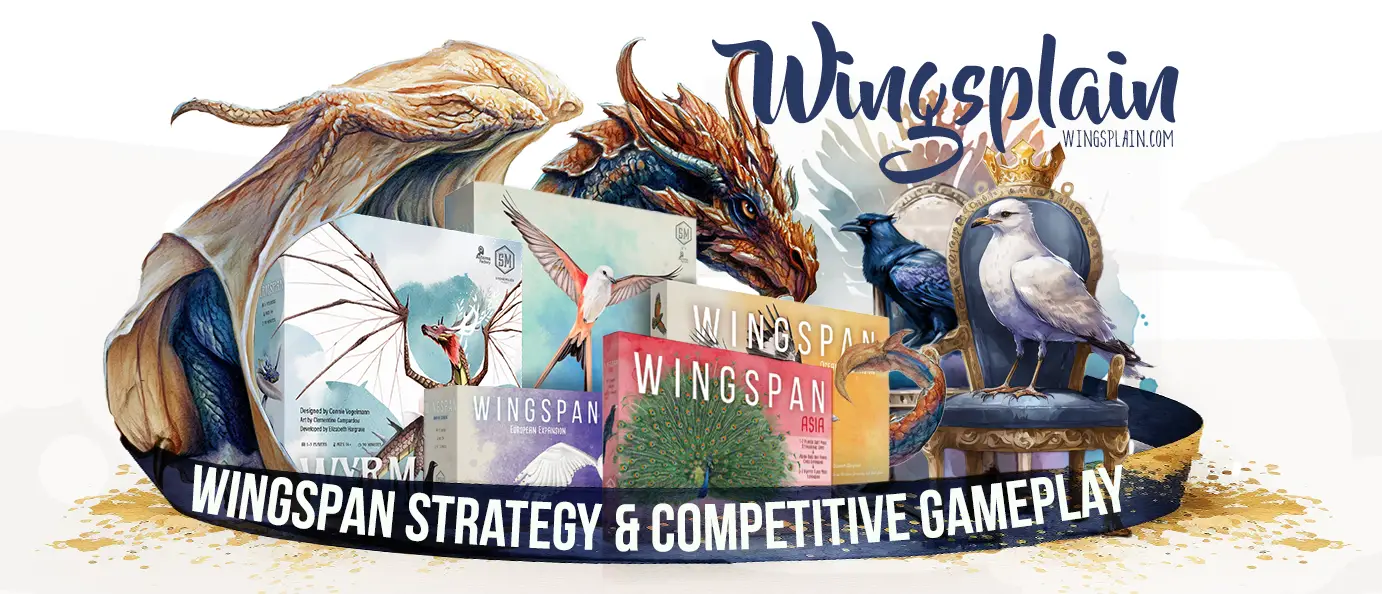
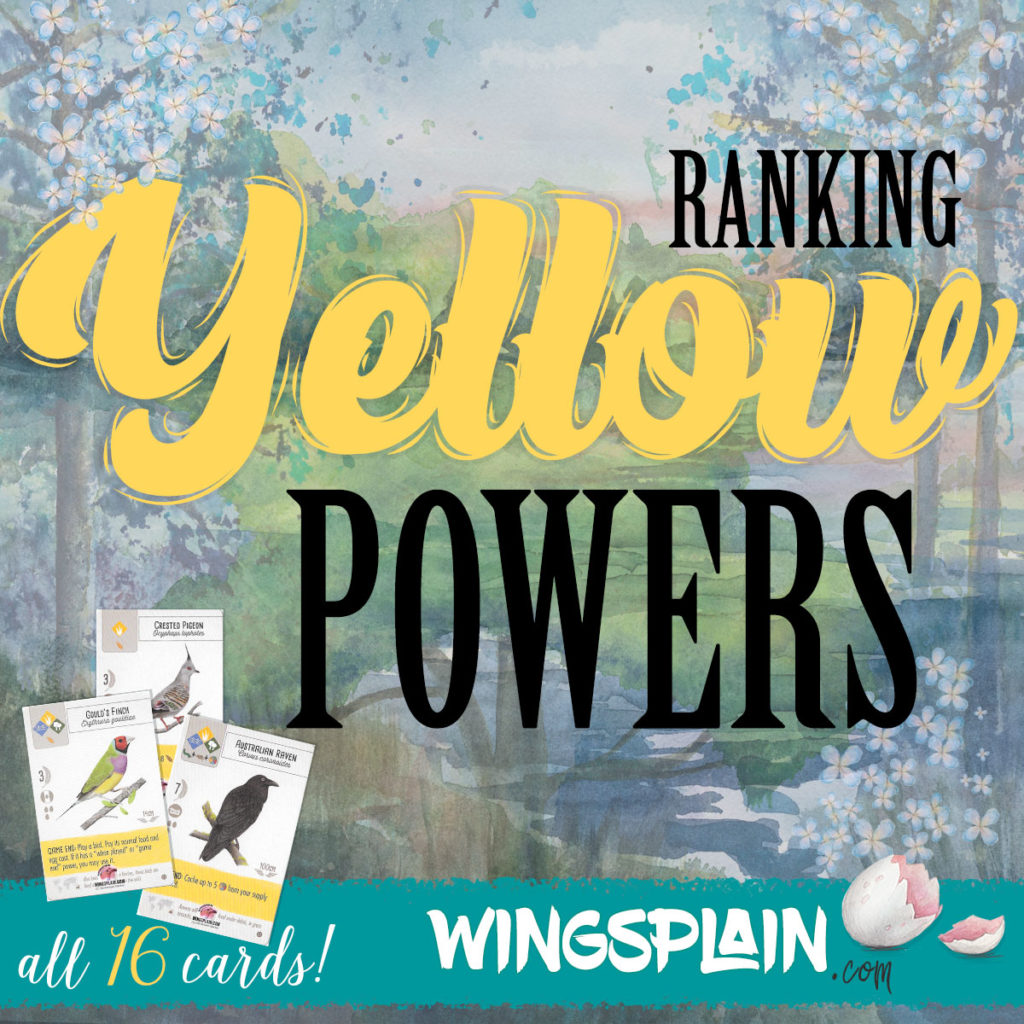
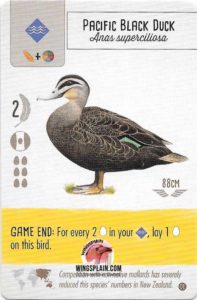
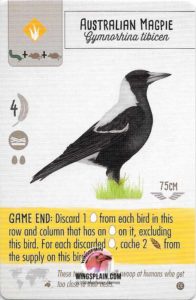
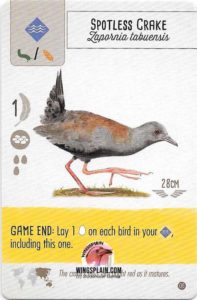
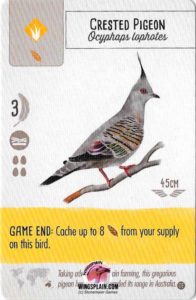
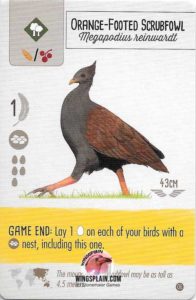
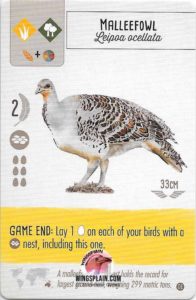
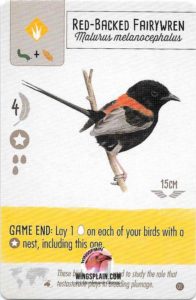
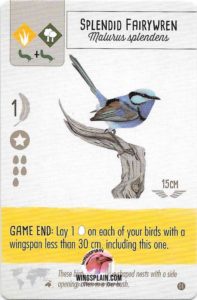
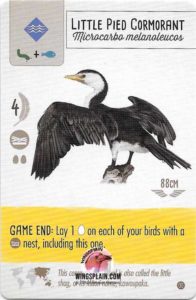
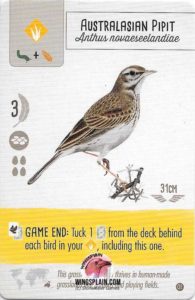
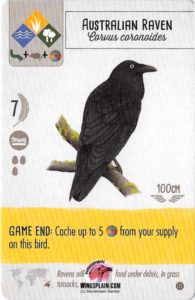
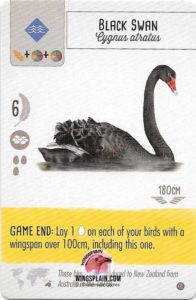
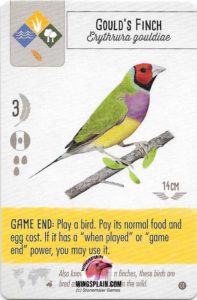
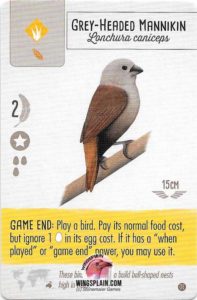
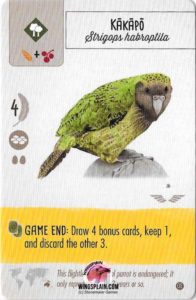
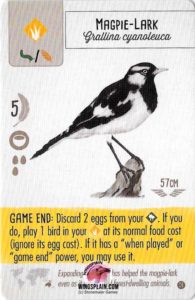
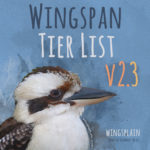
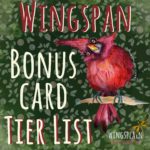
Awesome list! I think most of the placings are spot on, though I think you’ve overrated the magpie lark and underrated the Australian raven.
The Magpie lark is great for all the reasons you listed, but it’s end of game power only pulls it’s weight if you have the flexibility to put eggs in the woodland earlier and have an empty space in the grassland, which means you effectively need to give up 2 spaces in your grassland to use it. Not only is that too conditional to reliably hit without diverting too many resources, it also contradicts itself slightly, since it’s effect is easiest to pull off with a strong grassland engine, but to get its effect you can’t have that engine set up in the first place. Still, it’s a solid effect on a solid bird, I just don’t think it’s the best of the bunch. Personal I’d put just behind of the gray headed manikin but ahead of Gould’s finch.
As for the Australian Raven, this would be my pick for number 1, possibly number 2 behind the Kakapo. It’s a very flexible bird; you can play it as an afterthought and usually get 1 or 2 points from food that would be otherwise wasted, or in the best cases you can use it to score the full 5 points after finishing the game with a turn in a woodland engine because you either are full on eggs or just plain get more points with strong woodland birds (peaceful dove, chiffchaff, etc). It also contributes to several bonus cards directly and even more indirectly (I’m thinking all the habitat analysts cards; being a large game-end bird that can live anywhere makes it a natural fit for these goals).
Love the articles, can’t wait to see what’s next!
thank you for the information